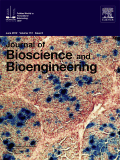
BIOTECHNOLOGY ADVANCES
Scope & Guideline
Advancing the Frontiers of Biotechnology
Introduction
Aims and Scopes
- Synthetic Biology and Genetic Engineering:
Research on the design and construction of new biological parts, devices, and systems, including advancements in CRISPR technology and genetic modifications of various organisms to enhance production capabilities. - Microbial Biotechnology:
Exploration of microbial systems for the production of high-value compounds, including enzymes, bioplastics, and biofuels, as well as the engineering of microorganisms to optimize metabolic pathways for industrial applications. - Biomanufacturing and Bioprocess Development:
Studies focusing on the optimization of bioprocesses for the production of recombinant proteins, enzymes, and other bioproducts, including techniques for scaling up production and improving yield. - Biotechnology in Agriculture:
Research on the application of biotechnological tools for crop improvement, pest resistance, and sustainable agricultural practices, including the use of genetically modified organisms (GMOs) and biopesticides. - Environmental Biotechnology:
Investigations into the use of biotechnological methods for environmental remediation, waste treatment, and sustainable resource management, emphasizing the role of microorganisms in bioremediation. - Bioinformatics and Computational Biology:
Application of computational tools and modeling techniques to analyze biological data, enhance metabolic engineering, and support synthetic biology initiatives. - Nanobiotechnology:
Development of nanomaterials and their application in biotechnology, including drug delivery systems, biosensors, and bioimaging.
Trending and Emerging
- Metabolic Engineering and Synthetic Biology:
There is a growing emphasis on integrating metabolic engineering with synthetic biology to create novel microbial chassis capable of producing complex biochemicals, reflecting the demand for sustainable production methods. - Machine Learning in Biotechnology:
The application of machine learning and artificial intelligence in biotechnological research is on the rise, facilitating data analysis, predictive modeling, and process optimization across various biotechnological applications. - CRISPR and Genome Editing Technologies:
Research on CRISPR and other genome editing technologies is expanding rapidly, with applications in agriculture, medicine, and industrial biotechnology, highlighting the versatility and potential of these tools. - Biomanufacturing of Bioactive Compounds:
There is a noticeable trend towards the biomanufacturing of bioactive compounds, including pharmaceuticals and nutraceuticals, from microbial and plant sources, driven by the demand for natural products. - Sustainable Bioprocessing and Circular Economy:
Emerging interest in sustainable bioprocessing techniques that align with circular economy principles, focusing on waste valorization and resource recovery from biological systems. - Environmental and Agricultural Biotechnology:
Increasing focus on biotechnological solutions for environmental challenges and agricultural sustainability, including bioremediation, biofertilizers, and biopesticides.
Declining or Waning
- Traditional Biocatalysis:
Research focused solely on traditional enzyme applications is decreasing as interest shifts toward more advanced methods such as enzyme engineering and biocatalysis integrated with synthetic biology. - Single-Organism Studies:
While studies on single microbial species were once prevalent, there is a noticeable decrease in interest as researchers increasingly focus on complex microbial communities and their interactions. - Basic Plant Biotechnology:
The application of basic biotechnological techniques in plants, such as simple genetic modifications, is less common as the focus has shifted to more complex genetic engineering and synthetic biology approaches. - Conventional Fermentation Processes:
Interest in conventional fermentation processes without significant innovation is declining, as newer, more efficient biotechnological methods emerge, emphasizing the need for process optimization.
Similar Journals

TRENDS IN BIOTECHNOLOGY
Leading the Charge in Bioengineering DiscoveriesTRENDS IN BIOTECHNOLOGY, published by CELL PRESS, stands as a premier journal since its inception in 1983, focusing on the dynamic and ever-evolving fields of bioengineering and biotechnology. With a notable impact factor and ranking in the top quartile (Q1) of its categories for 2023, this journal is recognized for its contribution to advancing scientific knowledge, boasting a Scopus rank of #5/311 in Biotechnology and #5/162 in Bioengineering, placing it in the 98th and 97th percentiles, respectively. Although it does not operate under an open access model, TRENDS IN BIOTECHNOLOGY ensures a rigorous peer-review process that provides a platform for high-quality research that influences both academic and industrial advancements. The journal's objectives encompass the dissemination of cutting-edge research findings, reviews, and insights that foster innovation in biotechnological applications, making it an invaluable resource for researchers, professionals, and students alike. With its broad scope across the intersection of biosciences and technology, TRENDS IN BIOTECHNOLOGY continues to lead discussions and developments that shape the future of the biotechnology landscape.

JOURNAL OF BIOSCIENCE AND BIOENGINEERING
Exploring the intersection of biology and technology.The JOURNAL OF BIOSCIENCE AND BIOENGINEERING, published by the SOC BIOSCIENCE BIOENGINEERING JAPAN, is an esteemed peer-reviewed journal dedicated to advancing knowledge in the fields of applied microbiology, biotechnology, and bioengineering. With its ISSN of 1389-1723 and E-ISSN 1347-4421, this journal has been providing a platform for innovative research since its inception in 1991, maintaining its relevance through periodic updates and a scope that encompasses various aspects of bioscience and engineering. The journal boasts a notable impact factor, reflecting its contributions to the Q2 and Q3 quartiles in relevant categories as of 2023, which positions it amongst the well-regarded publications in its field. Researchers and professionals can access its rich archive through open access options, ensuring wide dissemination of pivotal studies. With its address rooted in Osaka University, Japan, the journal serves as a vital resource for scientists and scholars committed to pushing the boundaries of biosciences and engineering.

JOURNAL OF INDUSTRIAL MICROBIOLOGY & BIOTECHNOLOGY
Unleashing the Power of Microbiology in IndustryJOURNAL OF INDUSTRIAL MICROBIOLOGY & BIOTECHNOLOGY, published by Oxford University Press, is a vital resource for researchers and professionals actively engaged in the fields of applied microbiology, biotechnology, and bioengineering. With an ISSN of 1367-5435 and E-ISSN of 1476-5535, this journal has established itself as a leading platform for disseminating innovative research findings and advancing knowledge in industrial microbiology since its inception in 1996. As of 2023, it is classified in the Q2 quartile across multiple categories including Applied Microbiology and Biotechnology, Bioengineering, and Medicine, underscoring its significance in the academic community. Notably, it ranks 26th of 127 in Applied Microbiology and Biotechnology, placing it in the 79th percentile, indicative of its high impact and influence. Although it does not currently offer Open Access, it remains a key outlet for high-quality scholarly articles that align with the objectives of improving industrial practices through biotechnological applications. For those interested in the latest developments and methodologies within the realm of applied microbiology and biotechnology, this journal serves as an indispensable reference.

Biotechnology Journal
Fostering a community of innovators in biotechnology.Biotechnology Journal, published by WILEY-V C H VERLAG GMBH, stands at the forefront of biotechnological research and innovation, recognized for its significant contributions to the fields of applied microbiology, molecular medicine, and broader biotechnology. With its ISSN 1860-6768 and E-ISSN 1860-7314, this journal has achieved impressive 2023 quartile rankings, positioning itself in Q1 for both Applied Microbiology and Biotechnology and Medicine (miscellaneous), and Q2 in Molecular Medicine, showcasing its impact and relevance within the scientific community. Based in Germany, the journal aims to disseminate high-quality research that drives advancements in biotechnological applications, fostering a platform for researchers, professionals, and students to engage with cutting-edge developments. With its ongoing commitment to excellence, the Biotechnology Journal is an essential resource for those seeking to stay informed about the latest trends and innovations in biotechnology.

New Biotechnology
Shaping the Future of Biotechnology and MedicineNew Biotechnology, published by Elsevier, is a distinguished academic journal focused on the innovative realms of biotechnology and bioengineering. With an impact factor reflecting its strong presence in the field, this journal serves as a vital resource for researchers and professionals in the life sciences, offering insights into cutting-edge advancements and applications in biotechnology, molecular biology, and related disciplines. The journal's open access policy enhances its accessibility, allowing broad dissemination of knowledge and research findings. With a robust set of Scopus ranks placing it in the top tiers of its categories, including rank #36 in Biotechnology and #24 in Bioengineering, New Biotechnology represents a critical platform for scholars aiming to contribute to the ongoing dialogue in these rapidly evolving fields. Since its inception in 2008 and continuing through to 2024, the journal remains committed to fostering innovation and collaboration among scientists dedicated to advancing biotechnological applications, thereby significantly impacting medicine and industry.

BIOTECHNOLOGY AND BIOPROCESS ENGINEERING
Elevating Knowledge in Biotechnology and BioengineeringBIOTECHNOLOGY AND BIOPROCESS ENGINEERING, published by the Korean Society for Biotechnology and Bioengineering, is a prominent journal in the fields of applied microbiology, biotechnology, bioengineering, and biomedical engineering. Since its inception in 1996, this journal has served as a vital platform for researchers and professionals, facilitating the dissemination of cutting-edge research and innovative applications related to bioprocesses and biotechnology systems. With an ISSN of 1226-8372, this journal is ranked within the Q3 quartile across several categories, demonstrating its relevance and impact in the academic community. Although it operates under traditional access modalities, the journal strives to provide quality and timely insights into the advancements in bioprocess technology and microbial applications, fostering a collaborative environment for knowledge exchange. Notably, it is indexed with a respectable presence on Scopus, making it a valuable resource for students and professionals seeking the latest developments in biotechnology. For more details, kindly refer to the Korean Science Technology Center, #704 Yeoksam-Dong, Gangnam-Ku, Seoul 135-703, South Korea.

BMC BIOTECHNOLOGY
Fostering Open Access to Cutting-edge ResearchBMC Biotechnology, a leading journal in the field of biotechnology, is published by BMC and has been a pivotal platform for open-access research since 2000. With a focus on the diverse areas of biotechnology, including biochemistry, genetics, and molecular biology, this journal holds a prestigious Q2 ranking in its category for 2023 and demonstrates a commendable percentile rank in the top 66th for its Scopus listings. Operating out of the United Kingdom and covering research from 2001 to 2024, BMC Biotechnology is committed to disseminating high-quality, rigorously peer-reviewed articles that foster advancements and innovations in the biotechnology landscape. Researchers, professionals, and students alike will benefit from the journal's rich content and dedicated commitment to enhancing scientific discourse within the realm of biotechnology.

Synthetic and Systems Biotechnology
Shaping Tomorrow’s Biotechnology LandscapeSynthetic and Systems Biotechnology, published by KEAI PUBLISHING LTD, is a pioneering open-access journal that has made significant contributions to the fields of applied microbiology, biotechnology, biomedical engineering, genetics, and structural biology since its inception in 2016. With an ISSN of 2405-805X, this journal is committed to fostering innovative research and interdisciplinary collaboration, providing a platform for the dissemination of high-quality studies that push the boundaries of scientific knowledge. Recognized for its excellence, it holds prestigious Q1 rankings in both Applied Microbiology and Biotechnology as well as Biomedical Engineering in 2023, alongside notable Q2 rankings in Genetics and Structural Biology. Researchers, professionals, and students alike can access cutting-edge research that explores the dynamic interplay between synthetic biology and systems biology, driving advancements that could reshape health, industry, and environmental sustainability. By operating under an open-access model, Synthetic and Systems Biotechnology ensures that new findings are accessible to a global audience, thereby maximizing the impact and reach of the published work and paving the way for future discoveries.

APPLIED BIOCHEMISTRY AND BIOTECHNOLOGY
Transforming Ideas into Impactful ApplicationsApplied Biochemistry and Biotechnology is a leading journal published by Springer, dedicated to advancing research in the interdisciplinary fields of biochemistry, biotechnology, and applied microbiology. Established in 1981, this peer-reviewed journal covers a wide range of topics that encompass innovative techniques, methodologies, and applications of biochemistry and biotechnology in medicine, environmental engineering, and molecular biology. With a Q2 ranking in several categories and an increasing impact factor, the journal demonstrates significant influence and credibility within the scientific community. While traditionally subscription-based, the journal offers avenues for open access through selective agreements, making high-quality research accessible to a broader audience. Researchers, professionals, and students alike will find Applied Biochemistry and Biotechnology to be an invaluable resource for the latest developments and applications in biochemistry and its related fields, aiding in the quest for sustainable solutions and novel biotechnological advancements.

Current Research in Biotechnology
Catalyzing Insights for a Sustainable Biotech FutureCurrent Research in Biotechnology is a leading journal published by Elsevier, dedicated to the dissemination of high-quality research in the rapidly evolving field of biotechnology. With an ISSN of 2590-2628, this journal has garnered a reputation for its insightful contributions, currently holding a prestigious Q2 ranking in the Biotechnology category, and placing in the 66th percentile within the Scopus rankings for Biochemistry, Genetics, and Molecular Biology. Running from 2019 and set to continue through 2024, the journal aims to provide a platform for groundbreaking studies that advance our understanding and application of biotechnological innovations. Although it operates under a subscription model, the journal ensures that research impacts a wide audience, facilitating collaboration among researchers, professionals, and students across the globe. By focusing on a diverse range of topics within biotechnology, Current Research in Biotechnology is committed to cultivating a vibrant discourse and fostering advancements that address critical challenges in health, agriculture, and environmental sustainability.